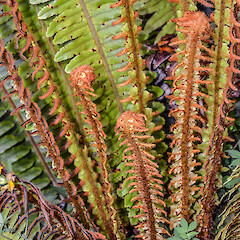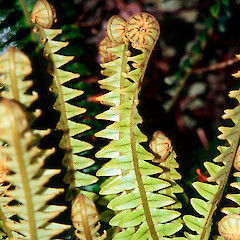Lomaria discolor
Common name
crown fern, petipeti, piupiu
Synonyms
Stegania discolor (G.Forst.) A.Rich.; Struthiopteris discolor (G.Forst.) Ching; Onoclea discolor (G.Forst.) Sw.; Osmunda discolor G.Forst.; Spicanta discolor (G.Forst.) Kuntze; Gymnopteris discolor (G.Forst.) Bernh.; Hemionitis discolor (G.Forst.) Schkuhr;Blechnum discolor (G.Forst.) Keyserl.
Family
Blechnaceae
Flora category
Vascular – Native
Endemic taxon
Yes
Endemic genus
No
Endemic family
No
Structural class
Ferns
NVS code
The National Vegetation Survey (NVS) Databank is a physical archive and electronic databank containing records of over 94,000 vegetation survey plots - including data from over 19,000 permanent plots. NVS maintains a standard set of species code abbreviations that correspond to standard scientific plant names from the Ngä Tipu o Aotearoa - New Zealand Plants database.
BLEDIS
Chromosome number
2n = 56
Current conservation status
The conservation status of all known New Zealand vascular plant taxa at the rank of species and below were reassessed in 2017 using the New Zealand Threat Classification System (NZTCS) – more information about this can be found on the NZTCS website. This report includes a statistical summary and brief notes on changes since 2012 and replaces all previous NZTCS lists for vascular plants.
Please note, threat classifications are often suggested by authors when publications fall between NZTCS assessment periods – an interim threat classification status has not been assessed by the NZTCS panel.
- Conservation status of New Zealand indigenous vascular plants, 2017 . 2018. Peter J. de Lange, Jeremy R. Rolfe, John W. Barkla, Shannel P. Courtney, Paul D. Champion, Leon R. Perrie, Sarah M. Beadel, Kerry A. Ford, Ilse Breitwieser, Ines Schönberger, Rowan Hindmarsh-Walls, Peter B. Heenan and Kate Ladley. Department of Conservation. Source: NZTCS and licensed by DOC for reuse under the Creative Commons Attribution 4.0 International licence.
2017 | Not Threatened
Previous conservation statuses
2012 | Not Threatened
2009 | Not Threatened
2004 | Not Threatened
Wetland plant indicator status rating
Information derived from the revised national wetland plant list prepared to assist councils in delineating and monitoring wetlands (Clarkson et al., 2021 Manaaki Whenua – Landcare Research Contract Report LC3975 for Hawke’s Bay Regional Council). The national plant list categorises plants by the extent to which they are found in wetlands and not ‘drylands’. The indicator status ratings are OBL (obligate wetland), FACW (facultative wetland), FAC (facultative), FACU (facultative upland), and UPL (obligate upland). If you have suggestions for the Wetland Indicator Status Rating, please contact: [Enable JavaScript to view protected content]
FACU: Facultative Upland
Occasionally is a hydrophyte but usually occurs in uplands (non-wetlands).
Flower colours
No flowers
Etymology
discolor: Two colours or of different colours; from the latin dis and color; different colours of the leaf surfaces
Taxonomic information
Perrie et al. (2014) advocated for a broadened circumscription of Blechnaceae whereby a number of genera traditionally recognised as distinct from Blechnum were merged within it. However, this view has not met with universal acceptance (see Gasper et al. 2016) and does not seem to be followed worldwide (PPG 2016). From a New Zealand perspective the decision to merge Doodia in Blechnum, and rejection of Diploblechnum has not been universally accepted either e.g., Wilcox & Warden (2017), and as such it is considered appropriate to follow world opinion and accept the taxonomy of Gasper et al. (2016) and recommendations of the PPG (2016).
References and further reading
Gasper AL, de Oliveira Dittrich VA, Smith AR, Salino A. 2016. A classification for Blechnaceae (Polypodiales: Polypodiopsida): New genera, resurrected names, and combinations. Phytotaxa 275: 191–227. https://doi.org/10.11646/phytotaxa.275.3.1.
Perrie LR, Wilson RK, Shepherd LD, Ohlsen DJ, Batty EL, Brownsey PJ, Bayly MJ. 2014. Molecular phylogenetics and generic taxonomy of Blechnaceae ferns. Taxon 63(4): 745–758. https://doi.org/10.12705/634.13.
PPG 1: The Pteridophyte Phylogeny Group 2016. A community-derived classification for extant lycophytes and ferns. Journal of Systematics and Evolution 54: 563–603. https://doi.org/10.1111/jse.12229.
Wilcox M, Warden J. 2017. Botany of Hillsborough coast bush reserves, Manukau Harbour, Auckland. Auckland Botanical Society Journal 72: 32–46.













